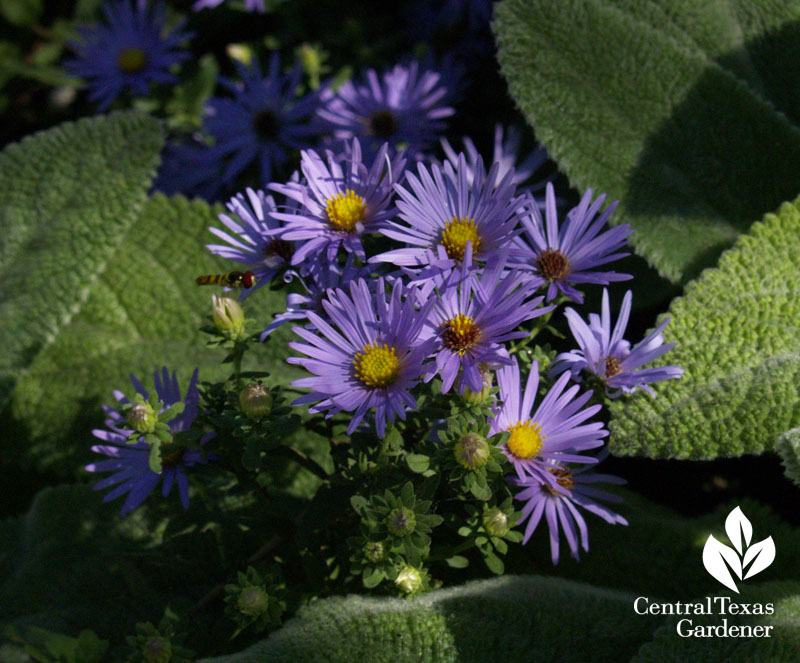November 1, 2012
Get the story on understory trees and plants
Lavender and silver, what a great duo! But this hoverfly wasn’t zooming in to admire ‘Helen von Stein’ lamb’s ears; it was going for lunch on the asters (Aster oblongifolius). Thanks, Meredith O’Reilly, for reminding me!

The fall-blooming asters join almost ever-blooming Blackfoot daisy that joins every seasonal companion.

When we dug out grass last spring along our new den path bed and laid down newspaper and mulch, I planned to fill the gaps this fall.

Well, the resident asters and ‘Country Girl’ mums jumped in to do the job for now! I’ll divide them when they go dormant this winter to push out their performance. At the far back is my latest acquisition, Manfreda x ‘Silver Leopard’ or Manfreda maculosa ‘Silver Leopard.’ In any case, its purple spots and silvery foliage will accent this bed nicely.

More on this project next week and what we’ve done about the weeds/grass on the right side!
Bees (and hummingbirds) also head for Pink fairy duster (Calliandra eriophylla).

This one’s not in my garden since it needs lots of sun and super drainage. But for those of you with that combo, Daphne makes this 3’ tall perennial her Pick of the Week.


You’ll also see Red Fairy Duster or Baja Fairy Duster (Calliandra californica), equally busy attracting pollinators all over town.

Mockingbirds and other berry-eaters are seeing red, too, as our native hollies fill their bellies.

My yaupon holly still bears evidence of a happy family raised near my front door this spring. I suspect the mail carrier got dive-bombed as often as we did by vigilant parents.
Since understory trees should not be overlooked in our gardens, this week Tom meets with Meredith O’Reilly, Texas Master Naturalist, NWF Habitat Steward, and Travis Audubon committee member.

Along with visual appeal under large shade trees, Meredith explains how the understory is important for nesting, food, and cover for small birds and song birds. One of her favorites is evergreen Goldenball leadtree.

Another on her list is Carolina buckthorn. This one’s growing under an ashe juniper in Liberty Hill.

Here’s her list that includes diverse situations, including Fragrant mimosa, Spicebush (larval food for the Spicebush Swallowtail butterfly), scarlet/red buckeye, and many more!
On Meredith’s blog, Great Stems, tour her progress as a native plant gardener in her urban habitat.

Her stunning photography also takes us along on her voyages to natural settings to meet both plants and wildlife and how they interact. Meredith’s also available for talks for all ages, though she certainly knows how to engage children in wildlife activities through her work with schools and Scout troops!
Since NOW is the best time to plant new trees, Daphne explains why you want to establish them this fall and early winter.

It’s also time to bring in house plants that you’ve summered outside. You’ll want to gently spray them down with water and even drench their soil with a weak solution of neem or orange oil and water (1 tablespoon to a gallon of water) so you don’t bring in some new friends, too! John Dromgoole cautions to use just VERY LITTLE to avoid harming root hairs. Another tip from John: when you repot, place some old window screen in the bottom to keep insects from coming in through the drainage hole.
This week on CTG, John shows how to fend off scale, red spider mites, and mealybugs on your houseplants. You can also use these tips on garden plants.

On tour, resident understory trees and other native plants influenced Christine and Pete Hausmann’s design in their garden, Lazy Acres. See their story of how they united three (now four!) generations with respect for the land.
Until next week, happy planting! Linda
tags:

